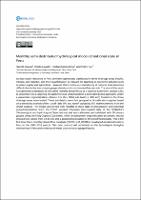| dc.contributor.author | Llauca, Harold | |
| dc.contributor.author | Lavado-Casimiro, W. | |
| dc.contributor.author | Montesinos Cáceres, Cristian Albert | |
| dc.contributor.author | Rau, Pedro | |
| dc.date.accessioned | 2021-06-30T14:48:57Z | |
| dc.date.available | 2021-06-30T14:48:57Z | |
| dc.date.issued | 2020 | |
| dc.identifier.citation | Llauca, H., Lavado, W., Montesinos, C., and Rau, P. (2020).: Monthly semi-distributed hydrological model at national scale in Peru, EGU General Assembly 2020, Online, 4–8 May 2020, EGU2020-3769, https://doi.org/10.5194/egusphere-egu2020-3769 | es_PE |
| dc.identifier.uri | https://hdl.handle.net/20.500.12542/1016 | |
| dc.description.abstract | Surface water resources in Peru are heterogeneously distributed in three drainage areas (Pacific, Titicaca, and Atlantic), and their quantification is relevant for planning in economic activities such as water supply and agriculture. However, their continuous monitoring at national scale becomes difficult due to the low stream gauges density and short streamflow records. The aim of this work is to generate a database of simulated monthly streamflows at a national scale from January 1981 to December 2016, applying the parsimonious GR2M model in a semi-distributed approach, under a parameter regionalization scheme. For this, 3594 sub-basins (~300 km2) located in the three drainage areas were tested. These sub-basins were first grouped in 14 calibration regions based on a sensitivity analysis of the runoff ratio (RR) and runoff variability (RV) indexes derived from the GR2M outputs. The model was forced with monthly gridded-data of precipitation and potential evapotranspiration from the PISCO product (Peruvian Interpolated data of the SENAMHI’s Climatological and hydrological Observations) and was calibrated and validated with 38 stream gauges using the Kling-Gupta (KGE) metric. After the parameter regionalization processes, results showed KGE values from 0.5 to 0.8, and a good representation of the runoff seasonality. This is the first time that a monthly streamflow database (PISCO-HyM_GR2M) is developed at national scale in Peru in the 1981-2016 period. This new product will contribute to the hydrological droughts monitoring in Peru and understand water balance on ungauged basins. | es_PE |
| dc.format | application/pdf | es_PE |
| dc.language.iso | eng | es_PE |
| dc.publisher | European Geosciences Union | es_PE |
| dc.relation.uri | https://meetingorganizer.copernicus.org/EGU2020/EGU2020-3769.html | es_PE |
| dc.rights | info:eu-repo/semantics/openAccess | es_PE |
| dc.rights | Atribución-NoComercial-SinDerivadas 3.0 Estados Unidos de América | * |
| dc.rights.uri | http://creativecommons.org/licenses/by-nc-nd/3.0/us/ | * |
| dc.source | Repositorio Institucional - SENAMHI | es_PE |
| dc.source | Servicio Nacional de Meteorología e Hidrología del Perú | es_PE |
| dc.subject | Modelos y Simulación | es_PE |
| dc.subject | Hydrological Model | es_PE |
| dc.subject | Cuenca Hidrográfica | es_PE |
| dc.subject | Caudal | es_PE |
| dc.title | Monthly semi-distributed hydrological model at national scale in Peru | es_PE |
| dc.type | info:eu-repo/semantics/conferenceObject | es_PE |
| dc.identifier.doi | https://doi.org/10.5194/egusphere-egu2020-3769 | |
| dc.subject.ocde | https://purl.org/pe-repo/ocde/ford#1.05.11 | es_PE |
| dc.subject.sinia | gestion de recursos hidricos de cuenca - Agua | |
| dc.type.sinia | text/libro.presentacion | |
| dc.identifier.url | https://hdl.handle.net/20.500.12542/1016 | |









